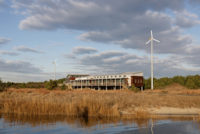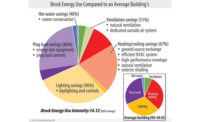The wait is over: the first projects have been certified as meeting the stringent terms of the Living Building Challenge (LBC). Two buildings have achieved full certification after their first year of operation, and a third has earned recognition for performing to LBC standards in four out of six categories. Although all three projects were completed by May 2009, they had to demonstrate through a year’s worth of data that they actually met design intentions for net-zero energy and water use.
The two projects achieving full certification—the Omega Center for Sustainable Living in Rhinebeck, New York, and the Tyson Living Learning Center in Eureka, Missouri—met the prerequisites for site, water, energy, materials, human health, and beauty. (Another set of prerequisites, dealing with social equity, was added in 2009.)
The third project—the Eco-Sense house in Victoria, British Columbia—achieved all of the “petals” of the metaphorical Living Building “flower” except for energy and materials. The owners, Ann and Gord Baird, had begun building their earthen home before LBC became available. Since they had already purchased many of the materials, some of which didn’t meet LBC specifications, and decided to use combustible fuel for heat, the Bairds could not pursue full LBC certification for their house.
The first projects to earn LBC certification faced significant challenges according to Sarah Costello of the Cascadia Green Building Council, which launched LBC in 2006 (LBC is now run by a sister nonprofit, the International Living Buildings Institute). “There’s no question that these project teams were pioneers, and things are harder for pioneers,” says Costello.
The materials “petal,” or set of prerequisites, presents significant challenges. Materials used in buildings must not use chemicals appearing on a “red list” that are perceived to be harmful, they must come from responsible sources, and from within a relatively short distance. Construction waste management and the carbon footprint of the construction process are also subject to stringent standards. “The materials petal was difficult, but they managed—and I think they appreciated it as an advocacy tool in spurring suppliers,” says Costello. When a project team uses a material that does not meet LBC requirements, it must send the manufacturer a letter noting that the product is being used despite its shortcomings, and present a copy of that letter in the certification application.
The requirement for net-zero energy presented a problem for the Tyson center. Although it achieved net-zero energy performance by the end of its first year in operation, producing almost 3,800 kWh of electricity more than it needed, the building needed some adjustments to get there. According to Kevin Smith, associate director of the center, the building was using more electricity than anticipated. After a thorough commissioning process, the project team faced a choice: add more photovoltaic (PV) panels or find a more holistic solution. "In the end we wanted a well-performing building that was as close to energy neutral as possible, rather than an under-performing building that had an overbuilt PV array to make up for it," says Smith. The team added insulation in several areas, retrofitted storm windows, and adjusting the HVAC system to improve the energy performance of the building.
The Omega Center for Sustainable Living also produced excess energy—about 15,000 kWh in the first year of occupancy. The building serves primarily as a water treatment plant, using a living machine and constructed wetlands to treat wastewater for an entire retreat center campus.
Achieving LBC certification, with all prerequisites and no credits (in contrast to most other rating systems, including LEED, with many optional credits) is difficult. But these three projects prove that it isn’t impossible. “These three projects have demonstrated that we have all of the skills and technology we need to completely transform the built environment,” says Jason McLennan, CEO of the International Living Building Institute, and in his role as chair of Cascadia, the founder of LBC.











Post a comment to this article
Report Abusive Comment